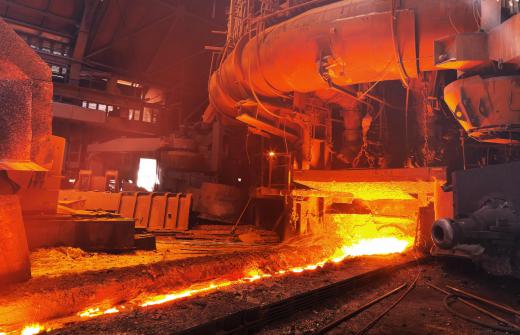At AboutMechanics, we're committed to delivering accurate, trustworthy information. Our expert-authored content is rigorously fact-checked and sourced from credible authorities. Discover how we uphold the highest standards in providing you with reliable knowledge.
What is Precious Metals Refining?
Precious metals refining is a technique used to purify precious metals. There are several different methods for refining precious metals, but the two main methods are pyrometallurgy, which involves heating, and hydrometallurgy, which involves dissolving the metals into a solvent. After purification, the metals are cleaned to complete the refining process.
Preparing for precious metals refining often involves taking a sample of the metal to be refined and creating an assay. During sampling, the metal is weighed, measured, and melted into a liquid, and then samples are taken. Usually one sample is retained by the refining company and another is given to the customer. After sampling, an assay is run to determine the exact amounts and concentrations of the precious metals and impurities to be removed.

Once the sample and assay are performed the precious metals refining process can begin, usually through pyrometallurgy or hydrometallurgy. During pyrometallurgy, the metal is heated and melted to separate the various impurities. In some metal processing, a form of gas will be used to bubble through the melted metal, and either the targeted precious metals or the impurities will oxidize, changing consistency to allow for removal. In some cases, the impurities and the precious metals melt at significantly different temperatures, which allows for easy separation by physical means.

A special type of pyrometallurgy, known as zone refining, is an expensive yet highly effective purification process. This precious metals refining technique involves stretching the metal that is to be purified into a long bar. The bar is then sequentially heated, starting at one end, and the impurities stay in liquid form and migrate down the bar when the next section is heated. At the end of the bar the impurities are collected in the last segment, allowing for easy removal. The process can be repeated several times, creating a loss of a significant portion of the metal, but leaving the rest of the metal purified.
Hydrometallurgy is the other main type of precious metals refining, and it involves using a solvent to dissolve the metal to remove the impurities. The first step of this process is known as leaching, during which the metal is dissolved using a solvent known as a lixiviant that is either acidic or basic. Next, the solution is purified through precipitation, extraction, or ion exchange processes. The last step is recovering the precious metals from the purified solution, and the techniques for this step include precipitation, electrorefining, and reduction by a gas. Hydrometallurgy is much more variable process, and the wide range of different methods allow it to be tailored for the individual sample that is to be refined.
AS FEATURED ON:
AS FEATURED ON:












Discuss this Article
Post your comments